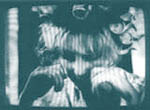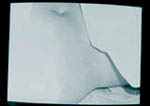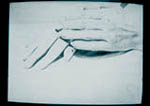 |




VERA PAVLOVNAíS DREAMS. A.ís ESCAPE, March
1998
Ledentsova Galina
It is possible to dwell only on the topic of the installation, if you wish. And to describe it as we usually tell the contents of many films: there is a life of three generations of one family before our eyes, Grandmother, Mother and daughters, the life with all its intricacies, customs and its own laws which are partially immanent, and partially thrust by the author.
The artist has chosen white tints for her installation that helps the viewer grasp the idea of the work at first sight: an endless interchange of life and death in eternity, and joy, sorrow and love being eternal either...
The parts of the installation are disposed in the form of a womanís figure lying in bed and covered with a bedspread. The author leaves for viewing only an open private and sacral part of a female body - belly.
Movement, quivering of life, images changing one another on the screen, all this stimulates the viewer to watch a picture for a pretty long time that, in its turn, destroys its dimension in aesthetic categories, transfering it into metaphysical ones. While meditating, the author forces a viewer to make a further step towards his own psychological problems and inward feelings. The very space of the work, both sound and visual, is meditative, extremely ascetic and aesthetized.
The name of the installation directly refers us to idealistic pictures of a communist society described in the dreams of the heroin of the novel "Whatís To Be Done?". However, mentioning a famous literary character in the title is nothing more than a bait. Here the author clearly demonstrates the position of an artificially detached view. ďVera PavlovnaĒ is a certain collective character, her name just testifies her belonging to some species and class, i.e. human being and female, and all the rest is sub-class and group. Besides, Vera Pavlovna is also an embodiment of the chains of a family circle, being reproduced and locked in a name-patronimic-name of a lacune which appears when one of the chains either dies, or leaves, or escapes.
The author keeps to a detached intriguing position in a visual sequence too, with the help of hyper close-ups and a slowed rhythm of the action lasting. The author has collected female images of one family, imperceptibly resembling each other both in appearance and inwardly. Common genetics leads to a common line of development, to fortunes that are fatally similar to one another. We feel sort of shudders while watching the fatality of these recurrences. Faces, plans, ages are sliding on the monitors changing one another. We wipe not only age differences but those ones of a personality as well, we wipe everybodyís individuality for the sake of a common bodyís life.
As for the function of the soul in the installation, it is, no doubt, performed by a hen. This is a special personage. On the one hand, this is a hen called Varya, with all unique charm of hers. On the other hand, educated people and experts in Russian philology, hope, would be pleased to face this archtype being the base of symbolism of the life and world origin, conceptions of the universe, meetings with the other world. Turning to the image of a hen naturally forms a theoretical base for plunging into subconscious and dream.
Dream means our anscestorsí offences and our anguish, dream means liberation of the soul, dream is a borderline state of being open to death and closed to life, dream is changing of direction, dream is minimum of movements. The artist has collected all these minimal movements, typical gestures, coverís quivering, to make every part of the body become an independent personage possessing its own features.
This attention to a part, increased by a dotted line of monitors and uncoordinated pictures, deliberate estrangement from images, be it with the help of a glass window, or a deceptive title, or an intermittent rhythm, or irrespectiveness of the audiotape, reveals the authorís balancing on the scale of selfidentification, mostly giving in to emotional merging of the author with an object.
Julia Kolerova, curator of TV Gallery
Art Media Center "TV Gallery" is thankful to Marat Guelman Gallery for the assistance in realization of the project, and to "Savvin" company for technical help.
Art Media Center "TV Gallery" is also thankful to the State Contemporary Art Center for their technical assistance in the presentation of the Gallery at the International Art Fair "ART-MOSCOW '98".
The site has been created with the assistance of the "Open Society Institute" (Soros Foundation). Russia
|






